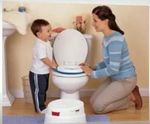Strategies for Toilet Training
←
→
Page content transcription
If your browser does not render page correctly, please read the page content below
Strategies for Toilet Training
These examples emphasize the need to consider a child’s over-all levels of development across domains in
order to avoid teaching skills in isolation. It is equally important to determine a child’s needs for supports
and accommodations. If a child is not able to verbally express the need to use the toilet (SC 20), then
strategies, instruction, and materials that allow the student to learn the skill should be put in place
(examples: picture icons, augmentative devices, signs)
Teachers should be aware that toilet training
takes time and the child may lose some
classroom time during toilet training.
Toileting programs for children with disabilities
often involve step-by-step instruction including
verbal, visual, and modeled prompts. It is
important to emphasize that toileting is an
important life skill that greatly increases a child’s
independence.
Emphasize to staff and parents that the time a
child spends with self-care routines is important
instructional time.
Consider schedules and preparation. Before beginning to teach the sequence of toileting skills,
spend several weeks preparing the student for the addition of toilet training into his/her daily schedule. A
good way to begin is by checking the child routinely for “dry” and “wet” times throughout the day.
Knowing when the child is dry or wet will help determine the best times to schedule toilet training times.
During this preparation time, the student can be taken into the bathroom, shown the bathroom part of the
daily schedule, and reinforced for participation in “going to the bathroom”. This serves to set up the
toileting process as a positive experience for the student and also emphasizes that toileting is part of the
daily routine.
Consider clothing. Teachers should suggest to parents that children wear pants with elastic that are
easy to remove. Some teachers and parents might agree to the use of training pants, as opposed to
diapers, to make it easier for the child to be aware of wetness. When teaching the children to pull up their
pants, it may be necessary to use hand-over-hand techniques; gradually fade the assistance as children
begin to perform the task on their own.
Consider comfort. Ensure your student feels secure on the toilet seat. Placing a
foot stool under the child’s feet and using a toilet insert/frame with handles may be
helpful. If your student is sensitive to or upset by the sensory aspects of going to
the toilet, try ways of controlling the sensory experience of toileting. For example:
Get the child familiar with sitting on the toilet seat by practicing for a few minutes
every day. Make sure he/she is comfortable. Use a foot stool if your child needs foot
support while sitting on toilet. Use a training seat if a student is frightened of the big
hole over the water. Prepare children for the noisy flushing sound, explain the reason
for the noise, but if a child continues to be sensitive or afraid of the noise, add
flushing as a final step but continue with the rest of the training steps.Positive Reinforcement is vital. Rewards should be used judiciously. When the child
has a toileting success, affirm him by smiling, clapping, and praising. You also can provide
treats. The ultimate reward for the child is staying comfortable and dry, and the child should
be praised for staying dry. Give specific and positive feedback for each step in the toileting
process achieved.
Use a timer to cue students that it is time to go to the potty. When the timer goes off, you will take
your child to the bathroom and say: “Time to go to the bathroom”. When the timer goes off again, tell
him/her: “Time to go to the bathroom”. Increase the amount of time between setting the timer as your
child remains dry for longer periods of time.
Use specific language. For example, say, ‘Eddie, sit on the toilet so you can have a wee’. This is
clearer than asking your child to ‘sit on the toilet’, and will help your child understand what to do. Choose
one word to refer to going to the toilet. Get everyone in the family to use it. For example, always say
‘toilet’ or whatever your family is comfortable with. Teach the student a way of letting teachers and
parents know she needs to go to the toilet. This could include nonverbal signing or the use of a picture or
verbalized words.
Provide classroom support by including a doll that can wet and
set a schedule so that a child can take the doll to toilet. Have a “potty
party”, clap, and say “hooray” when the doll “goes potty.” Provide
children’s books that focus on potty training. Make a social story book
specific to the student who is having difficulty with potty training.
Children’s Books for the Classroom
Below are listed some children’s books about using the
toilet. Books about toileting should be available in the
classroom library and can also be read to small groups
or individual children.
List reference: Parents’ Magazine
Potty by Leslis Patricelli
The Silly Potty Story by Vanessa Rouse
Once Upon a Potty: Girl and Once Upon a Potty:
Boy by Alona Frankel
How to Potty Train Your Monster by Kelly DiPucchio
Big Boy Potty and Big Girl Potty by Mary Lee
The Boss of the Potty by Henry Aabb
The New Potty by Gina Mayer
Dinosaur vs. the Potty by Bob Shea
Potty Superhero by Parragon Books
P is for Potty by Sesame Street BooksUse a visual schedule that outlines the steps in the toileting process. Story based interventions and
video modelling can also help children understand the toileting process. Positively reinforce toileting
success with rewards. This can be done by adding a picture of the reward to the end of the toileting
sequence. Go over the schedule with the child 2-3 times a day or more often depending on the toileting
schedule. Everyone who does toileting with students will need to know and follow the routine. This way,
training will be consistent.
Social Scripts with Visual Supports are useful in describing the toileting process to the student.
When writing a social script, use words and pictures that are appropriate for the student’s developmental
level and personalize the story. The story should be read to the student several times a day in preparation
for the toileting lesson. The social script does not take the place of the visual schedule.
Example of a simple visual Example of a detailed visual schedule for toileting
schedule for toileting with a chart for rewards included
Note: “Social Story” is a copyrighted term. The method
developed by Carol Gray for writing social stories uses five
sentences which present a situation, suggest actions, and
provide a positive outcome. Social stories should be
personalized and can include photos. It is recommended that a
story be read to a child several times a day and that it be read
in preparation and not during the activity.
Example of a Social Script for Toileting
Sometimes my body lets me know that I need to “use the bathroom”.
When this happens I can go into the bathroom and use the toilet.
I can sit on the toilet and “go” into the toilet.
When I’m finished I can flush the toilet, wash my hands, and return to what I
was doing.
When I “go” in the toilet, my underwear does not get wet or dirty.
My parents and teachers are proud of me when I go to the bathroom.Prompting Students during the Toileting Routine
Children who are not potty trained are likely to require prompting from adults in order to establish
and participate in a toileting routine at school. Some children who have been successful with potty
training at home might show some regression in toileting skills when they start school. It is
important to provide prompts throughout the routine until it successfully established in the daily
schedule. A brief description of prompt hierarchy (least to most) is listed below:
Verbal prompt – State to the child: “Time for bathroom; walk to the bathroom.”
Visual prompt – Show the child a picture of the bathroom symbol.
Modeling and Gesturing – Point toward the bathroom.
o Note: the three prompts listed above can be combined so that the adult shows the
picture and makes the verbal direction at nearly the same time.
o The picture icons used for prompting should be the same as those on the child’s
classroom or individual schedule.
Physical assistance – hand-over-hand help
o Partial physical assistance to get the student started – Take the child’s hand or use a
gentle touch at the shoulder or elbow to begin to guide him/her toward the bathroom.
o Full physical assistance throughout the entire step of the task. If needed, hold the
child’s hand until you reach the bathroom.
Some important aspects of using prompts are as follows:
Analyze the skill so that you know the steps of the task you are teaching your students.
o Consider the abilities of the child to perform the motor skills required to perform the
task. For example, be aware of difficulties in fine motor skills and/or hand and finger
strength and coordination required for initiating the step of pulling down pants.
Don’t forget the importance of positive reinforcement. Use various words, phrases, actions,
and tangible rewards so that the child does not become tired of or satiated with any one
reinforcement strategy.
Remember to use “Wait Time”. This is difficult to do sometimes, but it is necessary for
developing independence. After a prompt is given – Wait – in order to give the child time to
process the step of the task. Observe carefully so that you don’t help too soon.
Fade prompts as appropriate but don’t fade so quickly that you cause frustration. Make the
reinforcement for independent participation more exciting than reinforcement for hand-over-
hand participation.
Keep the focus on increasing the child’s participation.
It is especially important to provide opportunities for students with significant delay and significant
physical disabilities opportunities to participate as much as they are able. Even if a student is
unable to walk to the bathroom, he/she should be given opportunities to point toward, look toward,
or communicate in some way that it is time to go to the bathroom. Students who are unable to
initiate physical steps of toileting should be given opportunities to participate in such ways as
pointing to or asking for their personal items in the bathroom or participate by holding/handing the
adult needed items.References:
Aponte, Courtney and Mruzek, Daniel. Seven toilet training tips that help nonverbal kids with autism.
University of Rochester Medical Center, https://www.autismspeaks.org/blog/2016/02/12/seven-
toilet-training-tips-help-nonverbal-kids-autism
Hendricks, Dawn. Using prompts to promote skill acquisition. Virginia Commonwealth University Autism
Center for Excellence. http://www.vcuautismcenter.org
How to Write a Social Story: Tips and Resources for Teachers. Vanderbilt Kennedy Center, Nashville, TN.
https://vkc.mc.vanderbilt.edu/assets/files/tipsheets/socialstoriestips.pdf
Raising Children Network: Toilet Training for children with autism spectrum disorder
http://raisingchildren.net.au/articles/autism_spectrum_disorder_toilet_training.html
Inge, Katherine. Using a least to most prompt teaching strategy. Virginia Commonwealth University
Autism Center for Excellence. http://www.vcuautismcenter.org
Wheeler, Maria. Toilet Training for Individuals with Autism and Other Developmental Issues, Second
Edition. Future Horizons, 2007.You can also read

























































